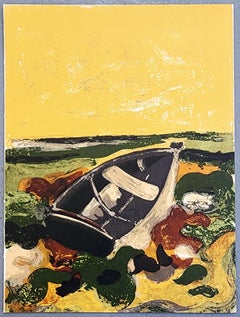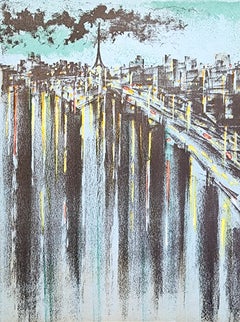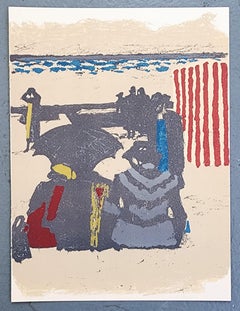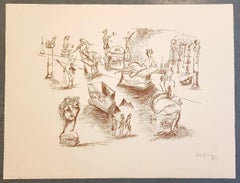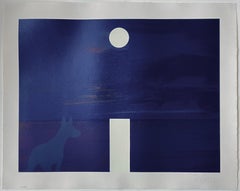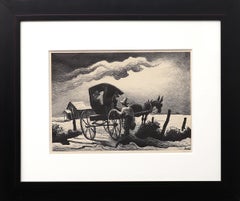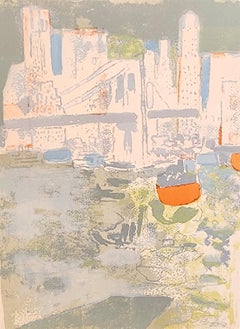Vellum Landscape Prints
to
4
4
1
3
2
3
2
Overall Height
to
Overall Width
to
4
3
2
2
1
1
1
1
1
1
1
1
1
1
1
1
1
1
5
4
1
1
1
1
1
202
4,804
3,007
2,481
1,344
Medium: Vellum
La Barque Echouee (Mourlot, Paris)
By Andre Minaux
Located in Kansas City, MO
Andre Minaux
La Barque Echouee
1964
Original Color Lithograph on Velin d'Arches
Size: 10x7.375in
Edition: 2,000
Annotated verso
Unsigned as issued
Publisher: Mourlot, Paris
Printer: ...
Category
1960s Modern Vellum Landscape Prints
Materials
Lithograph, Vellum
La Seine a Paris (75% OFF LIST PRICE FOR A LIMITED TIME, FRAMING OPTIONS AVAIL)
Located in Kansas City, MO
Richard Florsheim
La Seine a Paris
1964
Original Color Lithograph on Velin d'Arches
Size: 10x7.375in
Edition: 2,000
Annotated verso
Unsigned as issued
Publisher: Mourlot, Paris
Print...
Category
1960s Modern Vellum Landscape Prints
Materials
Lithograph, Vellum
Saint-Jean-de-Luz : La Plage Noir (Mourlot, Paris)
Located in Kansas City, MO
Maurice Brianchon
Saint-Jean-de-Luz : La Plage
1964
Original Color Lithograph on Velin d'Arches
Size: 10x7.375in
Edition: 2,000
Annotated verso
Unsigned as issued
Publisher: Mourlot,...
Category
1960s Modern Vellum Landscape Prints
Materials
Lithograph, Vellum
Romantische Reisende III
Located in Kansas City, MO
Bele Bachem
Romantische Reisende III
Lithograph on Velum
Year: 1967
Size: 19.25x25.5in
Signed, dated and inscribed by hand
Edition: 150
Publisher: Edition ...
Category
1960s Modern Vellum Landscape Prints
Materials
Vellum, Lithograph
Before the Trotting Race - Original Lithograph Handsigned Numbered
By Yves Brayer
Located in Paris, FR
Yves Brayer (1907-1990)
Before the Trotting Race
Original lithograph, c.1973
Handsigned in pencil by the artist
Numbered /250 copies
Size 50 x 65 cm, on Arches Vellum
Information: ...
Category
1970s Vellum Landscape Prints
Materials
Lithograph, Vellum
Related Items
Untitled
Located in San Francisco, CA
Artist: Billy Al Bengston – American (1934-2022)
Title: Untitled
Year: 1990
Medium: Lithograph, silkscreen on Arches paper
Sight size: 19.5 x 25.5 inches.
Sheet size: 24 x 30 inches.
Signature: Signed lower right
Publisher: Cirrus Editions, Ltd., Los Angeles, CA
Edition: 250 This one: 120/250
Condition: Excellent
This print is by Billy Al Bengston. It depicts what looks like a coyote staring out at the horizon on a full moon night. This print was created at the same time Bengston was creating his Moon paintings. The print has dark colors. As a result, my photographs are imperfect; they have a bit of glare. The print is in excellent condition. It is attached by two hinges to a matboard measuring 26 x 32 inches and has a Plexiglas frame. The frame is in fair condition with some light scratches.
Billy Al Bengston (June 7, 1934 – October 8, 2022) was an American visual artist and sculptor who lived and worked in Venice, California, and Honolulu, Hawaii. Bengston was probably best known for work he created that reflected California's "Kustom" car and motorcycle culture. He pioneered the use of sprayed layers of automobile lacquer in fine art and often used colors that were psychedelic and shapes that were mandala-like. ARTnews referred to Bengston as a "giant of Los Angeles's postwar art scene."
Early life and education
Bengston was born in Dodge City, Kansas, on June 7, 1934. His family relocated to Los Angeles in 1948. He attended Los Angeles City College in 1952. Subsequently, he studied painting under Richard Diebenkorn and Saburo Hasegawa at the California College of Arts and Crafts, in Oakland, California, in 1955 and returned to Los Angeles to study at Otis Art Institute in 1956.
Career
Bengston began showing with the Ferus Gallery in Los Angeles (founded and run by Walter Hopps and Edward Kienholz, and later Irving Blum), having five shows between 1958 and 1963. As a fixture at the gallery, he was among a cohort of artists that included Kienholz, Ed Ruscha, Larry Bell, Kenneth Price, Ed Moses, and Robert Irwin. (The gallery closed in 1966.) In a 2018 article in Vanity Fair, Bengston recalled that he and Irwin hung the 32 pieces in Andy Warhol's Campbell's soup-can paintings show at Ferus in 1962. He notably described the atmosphere of Ferus as a "macho intellectual gang bang".
After seeing the work of Jasper Johns at the 1958 Venice Biennale he adopted the motif of a set of sergeant's stripes. This recurring chevron image was painted with industrial materials and techniques associated with the decoration of motorcycle fuel tanks and surfboards. According to Grace Glueck of The New York Times, Bengston "was among the first to ditch traditional oil paint on canvas, opting instead for sprayed layers of automobile lacquer on aluminum in soft colors, achieving a highly reflective, translucent surface."
Bengston encouraged viewers in the early 1960s to associate his art with motorcycle subculture; on the cover of a 1961 catalogue for a Ferus show, he was seen straddling a motorcycle. (He also competed in motocross competitions.) "When I painted these motorcycle paintings...
Category
1990s Pop Art Vellum Landscape Prints
Materials
Lithograph, Screen, Paper
Gateside Conversation, 1940s Original Signed Lithograph by Thomas Hart Benton
Located in Denver, CO
'Gateside Conversation' is an original signed lithograph by Thomas Hart Benton (1889-1975) from 1946. Singed by the artist in the lower right margin and titled verso. Portrays a figu...
Category
1940s American Modern Vellum Landscape Prints
Materials
Paper, Lithograph
Ruins of Central City, Vintage 1935 Framed Colorado Modernist Landscape
Located in Denver, CO
Vintage lithograph titled "Ruins of Central City 31/70" is a modernist landscape with decaying buildings and mountains by Vance Hall Kirkland, from 1935. Presented in a custom black frame with archival materials, outer dimensions measure 25 ⅞ x 29 ⅜ x ⅝ inches. Image sight size is 14 x 17 ¾ inches.
Painting is clean and in very good vintage condition - please contact us for a detailed condition report.
Provenance: Private collection, Denver, Colorado
Expedited and international shipping is available - please contact us for a quote.
About the Artist:
Variously referred to as the "Father of Modern Colorado Painting", "Dean of Colorado Artists", and "Colorado’s pre-eminent artist," Kirkland was an inventive, visionary painter who spent fifty-two years of his fifty-four-year career in Denver. Of the approximately 1,200 paintings he created, about 550 from the first half of his career (1927-1953) are water-based media: acquarelle, gouache, casein and egg tempera, with a few oils. In the latter half of his career (1953-1981) he used oil and his unique oil and water mixture. He also produced five hundred drawings and some ten prints, mostly lithographs on stone, while also engaged in teaching full-time for most of the period.
To show people "something they have never seen before and new ways to look at things," he felt he needed to preserve his artistic freedom. Consequently, he chose to spend his entire professional career in Denver far removed from the established American art centers in the East and Midwest. "By minding my own business and working on my own," he said, "I think it was possible to develop in this part of the country… I’ve developed my kind of work [and] I think my paintings are stronger for having worked that way." The geographical isolation resulting from his choice to stay in Colorado did not impede his creativity, as it did other artists, but in fact contributed to his unique vision.
The son of a dentist, who was disappointed with his [son’s] choice of art as a career, Kirkland flunked freshman watercolor class in 1924 at the Cleveland School of Art (now the Cleveland Institute of Art) for putting colors into his landscapes that did not exist in nature and for competing colors. Not dissuaded, he won first prize for his watercolors in his junior and senior years. [While in Cleveland,] he studied with three influential teachers. Henry Keller, included in the prestigious New York Armory Show in 1913, introduced him to designed realism which he later used in his Colorado landscapes in the 1930s and 1940s. His other teachers were Bill Eastman, who studied with Hans Hofmann and appreciated all the new movements in modern art, and Frank Wilcox, a fine watercolorist.
While a student at the Cleveland School of Art, Kirkland concurrently took liberal arts courses at Western Reserve and the Cleveland School of Education and taught two freshman courses in watercolor and design, receiving his diploma in painting from the school in 1927 by doing four years of work in three. The following year he received a Bachelor of Education in Art degree from the same institution.
In 1929 he assumed the position of founding director of the University of Denver’s School of Art, originally known as the Chappell School of Art. He resigned three years later when the university reneged on its agreement to grant its art courses full recognition toward a Bachelor of Arts degree. His students prevailed on him to continue teaching, resulting in the Kirkland School of Art which he opened in 1932 at 1311 Pearl Street in Denver. The building, where he painted until his death in 1981, formerly was the studio of British-born artist, Henry Read, designer of the City of Denver Seal and one of the original thirteen charter members of the Artists’ Club of Denver, forerunner of the Denver Art Museum. The Kirkland School of Art prospered for the next fourteen years with its courses accredited by the University of Colorado Extension Center in Denver.
The teaching income from his art school and his painting commissions helped him survive the Great Depression. The U.S. Treasury Department’s Section of Fine Arts commissioned from him two post office murals, Cattle Roundup (1938, Eureka, Kansas), and Land Rush (1940, Sayre, Oklahoma). He also did murals for several Denver clients: the Gerald Hughes mansion (1936, later demolished), Arthur Johnson home (1936-37, Seven Drinks of Man), Albany Hotel (1937, later demolished), Neustetter’s Department Store (1937, "History of Costume," three of five saved in 1987 before the building interior was demolished in advance of its condo conversion), and the Denver Country Club (1945, partially destroyed and later painted over).
In 1953 the Ford Times, published by the Ford Motor Company, commissioned Kirkland along with fellow Denver artists, William Sanderson and Richard Sorby, to paint six watercolors each for the publication. Their work appeared in articles [about] Colorado entitled, "Take to the High Road" (of the Colorado Rockies) by Alicita and Warren Hamilton. Kirkland sketched the mountain passes and high roads in the area of Mount Evans, Independence Pass near Aspen, and Trail Ridge Road in Rocky Mountain National Park.
In 1946 Kirkland closed his art school when the University of Denver rehired him as director of its School of Art and chairman of the Division of Arts and Humanities. In 1957 the University gave him its highest honor – the "University Lecturer Award." When he retired in 1969 as Professor of Art Emeritus to become a full-time painter, the School of Arts was the university’s largest undergraduate department. In 1971 Governor John Love presented Kirkland the State of Colorado Arts and Humanities Award. In addition to his dual positions as artist and teacher in Denver for more than half a century, he served the Denver Art Museum as a trustee, chairman of the accessions committee, member of the exhibitions committee, curator of European and American art, and honorary curator of painting and sculpture. He also won the battle with the museum’s old guard to establish a department of modern and contemporary art. Additionally, he was one of the fifty-two founding members of the Denver Artists Guild which included most of Colorado’s leading artists who greatly contributed to the state’s cultural history.
Kirkland developed five major painting periods during his life encompassing various series with some chronological overlap: Designed Realism (1927-1944); Surrealism (1939-1954); Hard Edge Abstraction, including the Timberline Abstraction Series (1947-1957); Abstract Expressionism with four series – Nebulae, Roman, Asian, and Pure Abstractions (1951-1964); and the Dot Paintings with five series – Energy of Vibrations, Mysteries, Explosions, Forces, and Pure Abstractions (1963-1981).
Nevadaville (1931), a watercolor, belongs to Kirkland’s initial period of Designed Realism. Adapting nature by redesigning the realism he saw on location in Colorado allowed him to be "more concerned with the importance of the painting rather than the importance of the landscape." He noted that the rhythms his Cleveland teacher, Henry Keller, "found in nature created a certain movement in his paintings… [that moved] away from the static element of a lot of realistic, representational painting." Kirkland, along with fellow watercolorist Elisabeth Spalding, were some of the first Denver artists interesting themselves in Colorado’s nineteenth-century mining towns west of Denver. They offered an alternative to the overwrought cowboy and Indian subject matter of the previous generation; while the human and architectural components of the mining towns provided a welcome break from the predominant nineteenth-century landscape tradition.
Vibrations of Two Yellows in Space (1970), one of Kirkland’s small subseries of "Open Sun Paintings," occupies the final phase in his first series of dot paintings, Energy of Vibrations in Space (1963-1972). Many pieces in the series incorporate his unique mixture of oil paint and water which he developed in the early 1950s. The work in the subseries – a challenge to the viewer’s optic nerve – constitutes his contribution to the international realm of Op Art. Recalling the theory of pulsating galaxies and the universe, he used dots applied with dowels of different sizes to surround and leave round open spaces letting the gradient background show through. Because of the color contrast between the two, the "suns" either recede into the background or jump out in the foreground, creating the powerful pulsing effect.
During his lifetime he assembled on a limited budget an extensive collection of fine and decorative art and furniture. His collecting passion dated from his student days when he used his prize money from the Cleveland School of Art to purchase a watercolor by William Eastman and a now-famous set of Russian musician figures by Alexander Blazys, both of whom were his professors. After Kirkland’s death, the Denver Art Museum received a large bequest that included paintings by Roberto Matta, Gene Davis, Charles Burchfield, and Richard Anuszkiewicz (the two latter-named also alumni of the Cleveland Institute of Art); prints by Arthur B. Davies, Roberto Matta, Pablo Picasso, and Robert Rauschenberg; and a sculpture by Ossip Zadkine.
Kirkland posthumously was the subject of a television documentary, "Vance Kirkland’s Visual Language," aired on over one hundred PBS television stations (1994-96), and in 1999 a six-scene biographical ballet choreographed by Martin Friedmann with scenario provided by Hugh Grant, founder and director of the Kirkland Museum of Fine & Decorative Art in Denver. Historic Denver also posthumously honored Kirkland as part of the Colorado 100.
From 1997 to 2000 Kirkland’s solo exhibition was hosted by thirteen European museums: Fondazione Muduma, Milan; Sala Parpalló Museum Complex, València; Stadtmuseum, Düsseldorf; Frankfurter Kunstverein; Museum of Modern Art, Vienna; Kiscelli Múzeum and the Museum of Fine Arts, Budapest; Czech Museum of Fine Arts, Prague; National Museum, Warsaw; State Gallery of the Art of Poland, Sopot/Gdańsk, National Museum of Art, Kaunas, Lithuania; Latvian Foreign Art Museum, Riga; and the State Russian Museum, St. Petersburg.
Solo Exhibitions: Denver Art Museum (1930, 1935, 1939-40, 1942, 1972, 1978-retrospective, 1988, 1998); Colorado Springs Fine Arts Center (1943); Knoedler & Company, New York (1946, 1948, 1952); Pogzeba Art Gallery, Denver (1959); Galleria Schneider, Rome (1960); Birger Sandzén Memorial Gallery, Lindsborg, Kansas (1964-65,1977); Genesis Galleries, Ltd., New York (1978); Valhalla Gallery, Wichita, Kansas (1979); Inkfish Gallery, Denver (1980); Colorado State University, Fort Collins (1981- memorial exhibition); Boulder Center for the Visual Arts (1985); University of Denver, Schwayder Art Gallery (1991).
Group Exhibitions (selected): "May Show," Cleveland Museum of Art (1927-28); "Western Annuals," Denver Art Museum (1929-1957, 1964, 1966, 1968, 1971); "International Exhibition of Watercolors, Pastels, Drawings and Monotypes," Art Institute of Chicago (1930-1946); "Abstract and Surrealist American Art," Art Institute of Chicago (1947-48, traveled to ten other American museums); "Midwest Artists Exhibition," Kansas City Art Institute (1932, 1937, 1939-1942); Dallas Museum of Art (1933, 1960); San Diego Museum of Art (1941); "Artists for Victory," Metropolitan Museum of Art (1942); "United Nations Artists in America," Argent Galleries, New York (1943); "California Watercolor Society," Los Angeles County Museum (1943-1945); "Survey of Romantic Painting," Museum of Modern Art, New York (1945); New Mexico Museum of Art, Santa Fe (1945, 1951); Knoedler & Company, New York (1946-57; co-show with Max Ernest, 1950; co-show with Bernard Buffet, 1952); Joslyn Art Museum, Omaha (1948, 1956); Philbrook Art Center, Tulsa, Oklahoma (1951); "Contemporary American Painting," University of Illinois, Urbana (1952); University of Utah, Salt Lake (1952-53); Oakland Art Museum (1954-55); "Reality and Fantasy, 1900-54," Walker Art Center, Minneapolis (1954); "Art U.S.A.," Madison Square Garden, New York (1958); Roswell Museum and Art Center, New Mexico (1961); Burpee Art Museum, Rockford, Illinois (1965-68); University of Arizona Art...
Category
1930s American Modern Vellum Landscape Prints
Materials
Paper, Lithograph
H 25.75 in W 29.5 in D 0.5 in
Le Contis Sharp-tailed Bunting: Original Audubon Hand-colored Bird Lithograph
Located in Alamo, CA
This is an original 19th century John James Audubon hand-colored lithograph entitled "Le Contis Sharp-tailed Bunting, Male", No. 98, Plate 488 from Audubon's "Birds of America, litho...
Category
Mid-19th Century Naturalistic Vellum Landscape Prints
Materials
Lithograph
Golden Eagle: An Original 19th C. Audubon Hand-colored Bird Lithograph
Located in Alamo, CA
This is an original John James Audubon hand-colored lithograph entitled "Golden Eagle", No. 3, Plate 12 from Audubon's "Birds of America, lithographed, printed and colored by JT Bowe...
Category
Late 19th Century Naturalistic Vellum Landscape Prints
Materials
Lithograph
Yellow-billed Cuckoo: An Original 1st Ed. Audubon Hand-colored Bird Lithograph
Located in Alamo, CA
This is an original 1st octavo edition John James Audubon hand-colored lithograph entitled "Yellow-billed Cuckoo, 1. Male, 2, Female, Papaw Tree", No. 55, Plate 275 from Audubon's "B...
Category
Mid-19th Century Naturalistic Vellum Landscape Prints
Materials
Lithograph
Birds on Branches - Lithograph in Ink on Paper - Edition of 75
Located in Soquel, CA
Birds on Branches - Lithograph in Ink on Paper - Edition of 75
Delicate and detailed lithograph of birds by Fugi Nakamizo (Japanese/American, 1889-1950)...
Category
Early 20th Century Impressionist Vellum Landscape Prints
Materials
Lithograph, Ink, Paper
H 14.75 in W 19.75 in D 0.38 in
The Texan Turtle Dove: An Original 19th C. Audubon Hand-colored Bird Lithograph
Located in Alamo, CA
This is an original 19th century John James Audubon hand-colored lithograph entitled "The Texan Turtle Dove, Male", No. 100, Plate 496 from Audubon's "Birds of America, lithographed,...
Category
Mid-19th Century Naturalistic Vellum Landscape Prints
Materials
Lithograph
American Coot: An Original 19th C. Audubon Hand-colored Bird Lithograph
Located in Alamo, CA
This is an original 19th century John James Audubon hand-colored lithograph entitled "4128 Audubon, Purple Gallinule, Adult Male, Spring Plumage", No. 61, Plate 303 from Audubon's "B...
Category
Mid-19th Century Naturalistic Vellum Landscape Prints
Materials
Lithograph
Barn Owl Family: A Framed Original 19th C. Hand-colored Lithograph by Gould
Located in Alamo, CA
This is a framed original 19th century hand-colored folio-sized lithograph entitled “Strix Flammea” (Barn Owl) by John Gould, from his "Birds of Great Britain", published in London between 1862 and 1873. The print depicts an adult Barn Owl perched on a log its three baby owls to the left. Another adult owl in the background on the right, presumably a male, watches over his family. There are leaves on the right contributing to this pleasant landscape composition.
This striking framed Gould...
Category
Mid-19th Century Naturalistic Vellum Landscape Prints
Materials
Lithograph
Common Scaup Duck: An Original 19th C. Audubon Hand-colored Bird Lithograph
Located in Alamo, CA
This is an original 19th century John James Audubon hand-colored lithograph entitled "Common Scaup Duck, 1. Male, 2. Female", No. 100, Plate 498 from Audubon's "Birds of America, lithographed, printed and colored by J. T. Bowen and published in Philadelphia in 1856. It depicts male and female Scaup ducks sitting on a mound, looking to the right at water. A lighthouse is seen on a point of land in the background on the right.
This original hand-colored Common Scaup Duck lithograph...
Category
Mid-19th Century Naturalistic Vellum Landscape Prints
Materials
Lithograph
Carousel Animals: A Limited Edition Goines Graphic Art Poster
Located in Alamo, CA
This original limited edition graphic art lithographic poster entitled "Carousel Animals" was created by David Lance Goines in 1984 in his Berkeley ...
Category
Late 20th Century Vellum Landscape Prints
Materials
Lithograph
Previously Available Items
Le Port de New York (Mourlot, Paris)
Located in Kansas City, MO
Paul Guiramand
Le Port de New York
1964
Original Color Lithograph on Velin d'Arches
Size: 10x7.375in
Edition: 2,000
Annotated verso
Unsigned as issued
Publisher: Mourlot, Paris
Print...
Category
1960s Modern Vellum Landscape Prints
Materials
Vellum, Lithograph
Horseback Riding in the Forest - Original Lithograph Handsigned Numbered
By Yves Brayer
Located in Paris, FR
Yves Brayer (1907-1990)
Horseback Riding in the Forest
Original lithograph, c.1973
Handsigned in pencil by the artist
Numbered /250 copies
Size 50 x ...
Category
1970s Vellum Landscape Prints
Materials
Vellum, Lithograph
Siemens #5
Located in Washington, DC
Bernard Buffet Siemens #5
Artist: Bernard Buffet
Medium: Lithograph on vellum
Title: Siemens #5
Portfolio: Siemens
Year: 1968
Framed Size: 17" x 30 3/4"
Sheet Size: 15 1/2" x 29 1/4"...
Category
1960s Vellum Landscape Prints
Materials
Vellum, Lithograph
Vellum landscape prints for sale on 1stDibs.
Find a wide variety of authentic Vellum landscape prints available on 1stDibs. While artists have worked in this medium across a range of time periods, art made with this material during the 20th Century is especially popular. There are many well-known artists whose body of work includes ceramic sculptures. Popular artists on 1stDibs associated with pieces like this include Yves Brayer, Maurice Brianchon, Richard Florsheim, and Paul Guiramand. Frequently made by artists working in the Modern, all of these pieces for sale are unique and many will draw the attention of guests in your home. Not every interior allows for large Vellum landscape prints, so small editions measuring 0.01 inches across are also available
Recently Viewed
View AllMore Ways To Browse
Andy Warhol Brillo
American Propaganda Posters
Hunt Slonem Bunny Diamond
Frank Hudson
Tonalist School
Sitting Room Painting
Oil Paintings Of Water Lilies
Horse Painting Stable
Picasso Steel
Antique Impressionist Drawing
London Panorama
Haystack Oil Painting Landscape
Ernest Hemingway
Sunset Window
Old Luxembourg
St Louis China
Russian Farm
Olympic Athlete
